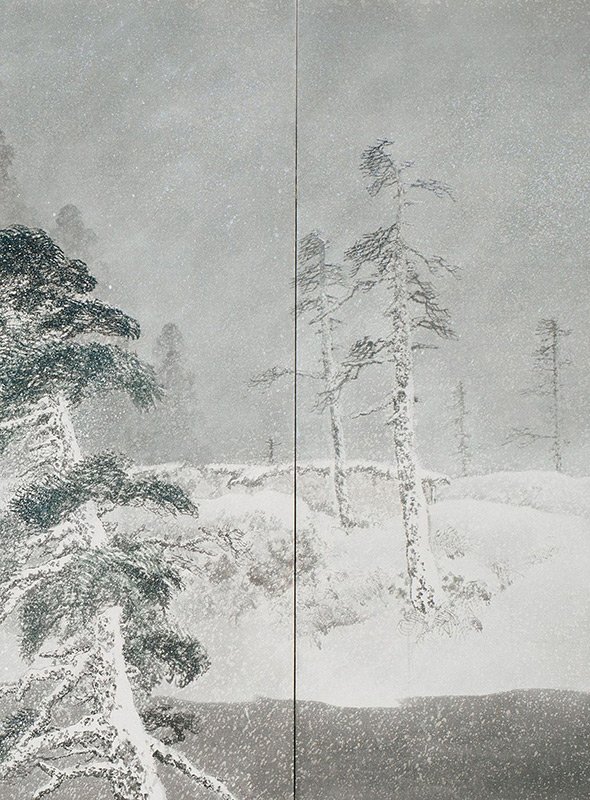PAINTINGS & SCREENS
KAWASHIMA BAIKYU, 1919, PAIR OF BYOBU WITH MOUNT KOYA IN SNOW
Pair of byobu or folding screens in six panels, painted on paper in mineral pigments, gofun or clam shell gesso, and sumi ink with a blizzard scene of a temple on Mount Koya. Signed on the lower right corner of the right-hand screen: Baikyu, and sealed: Baikyu; and sealed on the lower left corner of the left-hand screen with a different seal: Baikyu (Kawashima Baikyu, born Meiji 29 or 1896). Taisho 8 or 1919.
A paper label attached to the reverse of one screen is inscribed: Taisho Hachi Nen, Ju-ni Gatsu, Kyoto Kawashima Baikyu Hitsu, Teiten Shuppin Byobu Rakusen ni Tsuki…Koya San Kankei, Isso or Taisho (era) Eighth Year, (1919) December, Painted by Kawashima Baikyu of Kyoto, Screens Made for Exhibition at the Teiten (and) Refused, Winter Scenery of Mount Koya, A Pair, and then information as to their sale for 100 Yen, and the statement that the screens are: Sofuku Tango Seshi or Exploratory and Finely Painted.
This label suggests reasons why these beautifully painted screens were refused for exhibition by the Teiten vetting committee. Perhaps they were considered too experimental, the blizzard of snow too abstract in the way it obscures the details of the landscape and buildings. Regardless, the rejection must have been very embittering to the young painter. Had these paintings been submitted to the Teiten even ten years later, they would almost certainly have been accepted and acclaimed.
We know very little of Kawashima Baikyu beyond the fact that he was born in 1896 and lived in Kyoto. He apparently studied painting under Shoda Kakuyu (1879 – 1948), a professor at the Kyoto City Special Painting School and noted landscape painter. Shoda Kakuyu was himself a student of Yamamoto Shunkyo, to whom Kakuyu was related by marriage. Shunkyo often painted snow scenes, so this influence may found in Baikyu’s present work. In 1918, Baikyu had a painting accepted into the 12th Bunten (Nittenshi, volume 5, page 310, number 46), so the major effort these screens represent hardly prepared him for their unfortunate reception. Furthermore his connection with Shoda Kakuyu and Yamamoto Shunkyo, both prominent and well respected painters, must have made the Teiten refusal all the more unexpected. Still, the experience was one many of Baikyu’s contemporaries encountered. Even the most important painters met with varying success at the official exhibitions. Sakakibara Shiho along with Murakami Kagaku, Irie Hako, Ono Chikkyo and Nonagase Banka, actually broke away from the government-sponsored venues in 1918 to form the Kokuga Sosaku Kyokai (Association for the Creation of National Painting). This private group provided an alternative venue for its members to show their work until it disbanded in 1928. Despite his obvious talent, the young Baikyu took a different path, one that sadly led him afterwards to disappear into obscurity.
Famous for its ancient Shingon temples and haunting forests, Mount Koya has long possessed an aura of mystery. Painting one of Japan’s most sacred places, Baikyu stresses the ascetic isolation of the mountain with the imagery of a blinding snow storm. His rendering of the snow itself blurs the landscape, an effect at once extremely realistic and abstract. An almost bewildering variation in the way the white gofun and sumi ink are blended produces endless shades of snow and surprising pictorial depth. The buildings seem remote, enfolded in white silence among wind-swept pines. The dark water of a pond in the foreground balances the grey sky and the silhouettes of the trees. Winter is a season to turn inwards, to consider endings, mortality and the eternal themes Koya would naturally suggest to contemporaries. By focusing on the storm itself, Baikyu reminds us of nature’s overwhelming power and beauty.
For another pair of screens by Kawashima Baikyu, c.f. Kagedo’s catalogue Blue Wind, number 95.
Kawashima Baikyu, 1919, Pair of Byobu with Mount Koya in Snow
Artist Name: Kawashima Baikyu
Period: Meiji Taisho
Mediums: Mineral Pigments
Form: Screen
Origin Country: Japan
67 1/8” high x 148 ¼” across, dimensions of each screen when opened flat
This piece is no longer available.


